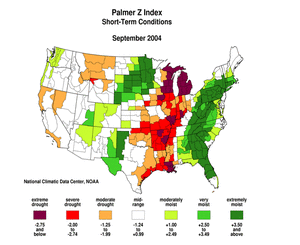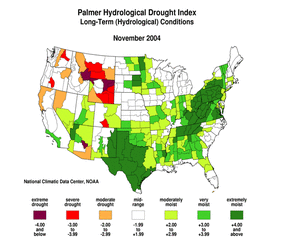U.S. Drought Highlights:
- On the national scale, severe to extreme drought affected about 14 percent of the contiguous United States as of the end of September 2004.
- Moderate to extreme drought affected about 25 percent of the contiguous U.S.
- Record rains in the eastern U.S. from three tropical systems inundated the remnant drought areas of the Southeast. Heavy rains also fell from the northern Plains to parts of the Southwest, bringing short-term relief to some of the drought areas of the central Plains and Southwest.
- In between these two September wet bands was a large swath of very dry conditions which stretched from the Great Lakes to the Lower Mississippi Valley and southern Plains. The southwestern quarter of the country was also dry.
- Long-term moisture deficits (last 6 to 24 to 60 months) persisted across parts of the mid-Mississippi Valley and northern High Plains, and most of the West.
Please Note: The data presented in this drought report are preliminary. Ranks, anomalies, and percent areas may change as more complete data are received and processed.
National Overview
On the national scale,
- severe to extreme drought affected about 14 percent of the contiguous United States as of the end of September 2004, a decrease of about 4 percent compared to last month
- about 25 percent of the contiguous U.S. fell in the moderate to extreme drought categories (based on the Palmer Drought Index) at the end of September
- on a broad scale, the last two decades were characterized by unusual wetness with short periods of extensive droughts, whereas the 1930s and 1950s were characterized by prolonged periods of extensive droughts with little wetness
- about 15 percent of the contiguous U.S. fell in the severely to extremely wet categories at the end of September
- a file containing the national monthly percent area severely dry and wet from 1900 to present is available
- historical temperature, precipitation, and Palmer drought data from 1895 to present for climate divisions, states, and regions in the contiguous U.S. are available at the Climate Division: Temperature-Precipitation-Drought Data page in files having names that start with "drd964x" and ending with "txt" (without the quotes).
Regional Overview
Record rains in the eastern U.S. from three tropical systems inundated the remnant drought areas of the Southeast. Heavy rains also fell from the northern Plains to parts of the Southwest, bringing short-term relief to some of the drought areas of the central Plains and Southwest
In between these two September wet bands was a large swath of very dry conditions which stretched from the Great Lakes to the Lower Mississippi Valley and southern Plains. The southwestern quarter of the country and parts of the northern Rockies and High Plains were also dry.
The precipitation pattern at the primary stations in Alaska and Hawaii was mixed, although most Alaska stations were wetter than normal. September was generally wet to near normal in Puerto Rico, based on both the primary station precipitation reports and on streamflow.
Long-term moisture deficits (last 6 to 24 to 60 months) persisted across parts of the mid-Mississippi Valley, central Great Plains, and northern High Plains, and most of the West. In spite of the record heavy tropical rainfall during September, the Southeast over the last 5 years was so dry that slight deficits still appear on the 48-month and 60-month precipitation anomaly maps.
Some regional highlights:
- Several states had the tenth driest, or drier, month or season for:
- September (Arkansas-2nd, Indiana-2nd, Michigan-2nd, Illinois-4th, Louisiana-6th, Missouri-6th)
- July-September (Louisiana-5th)
- April-September (California-3rd)
- March-September (California-driest)
- Maine was the only east coast state that received below-normal rainfall in September, ranking 24th driest
- Soil moisture conditions:
- End-of-month soil moisture conditions were drier than normal in parts of the Lower and Mid-Mississippi Valley, Upper Midwest, northern High Plains, and Alaska, and drier than normal across much of the West, based on model computations (CPC-1, CPC-2, MRCC).
- late September USDA topsoil moisture observations were dry to very dry (also compared to 5-year and 10-year climatologies) in states in the central and southern Great Plains, northern Rockies and northern High Plains, and especially along the Mississippi Valley to Great Lakes.
- According to early October USDA reports, more than 30 percent of the pasture and range land was in poor or very poor condition (higher than seasonal norms) in several states in the West, central and northern Plains, and along the Lower Mississippi Valley and Great Lakes. The most rapid 4-week deterioration in pasture conditions occurred along the Mississippi Valley to Great Lakes.
- The month began with several large wildfires burning in Alaska and the western U.S., but by month end the fires were largely put out or under control (wildfire loop).
- Much of the western U.S. has experienced dry conditions for the last five to six years.
- Reservoirs in the western states were still low or depleted.
- Streamflow levels were below seasonal norms across much of the West, both as computed by models and based on USGS observations. Below-normal monthly streamflows were also observed in parts of the central Plains, Great Lakes, and Mississippi Valley.
- The percent area of the western U.S. (Rockies westward) experiencing moderate to extreme drought (as defined by the Palmer Drought Index) decreased during September to about 64%. While this is not near record historical levels, it is still comparable to the major droughts of the 20th Century.
 NOAA's National Centers for Environmental Information
NOAA's National Centers for Environmental Information

